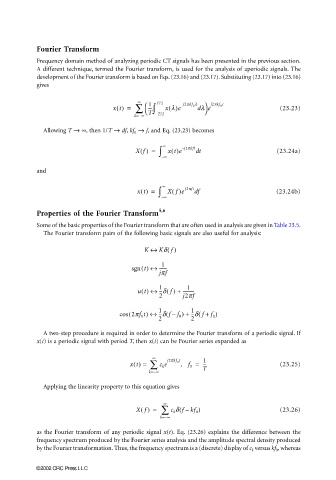Page 706 - The Mechatronics Handbook
P. 706
0066_Frame_C23 Page 14 Wednesday, January 9, 2002 1:53 PM
Fourier Transform
Frequency domain method of analyzing periodic CT signals has been presented in the previous section.
A different technique, termed the Fourier transform, is used for the analysis of aperiodic signals. The
development of the Fourier transform is based on Eqs. (23.16) and (23.17). Substituting (23.17) into (23.16)
gives
∞ T/2 j2πkf λ
1
xt() = ∑ --- ∫ x λ()e – 0 d λ e j2πkf t 0 (23.23)
k=∞ T – T/2
–
Allowing T → ∞, then 1/T → df, kf 0 → f, and Eq. (23.23) becomes
∞
Xf() = ∫ xt()e – j2πkft t d (23.24a)
– ∞
and
xt() = ∫ ∞ Xf()e j2πft f d (23.24b)
– ∞
Properties of the Fourier Transform 5,6
Some of the basic properties of the Fourier transform that are often used in analysis are given in Table 23.5.
The Fourier transform pairs of the following basic signals are also useful for analysis:
K ↔ Kδ f()
1
sgn t () ↔ -------
jπf
1
ut() ↔ 1 --δ f() + ----------
2 j2πf
--δ ff 0 ) +
cos ( 2pf 0 t) ↔ 1 ( – 1 --δ f +( f 0 )
2 2
A two-step procedure is required in order to determine the Fourier transform of a periodic signal. If
x(t) is a periodic signal with period T, then x(t) can be Fourier series expanded as
∞
xt() = ∑ c k e j2πkf t , f 0 = 1 (23.25)
0
---
k=∞ T
–
Applying the linearity property to this equation gives
∞
(
Xf() = ∑ c k δ fkf 0 ) (23.26)
–
k=∞
–
as the Fourier transform of any periodic signal x(t). Eq. (23.26) explains the difference between the
frequency spectrum produced by the Fourier series analysis and the amplitude spectral density produced
by the Fourier transformation. Thus, the frequency spectrum is a (discrete) display of c k versus kf 0 , whereas
©2002 CRC Press LLC

